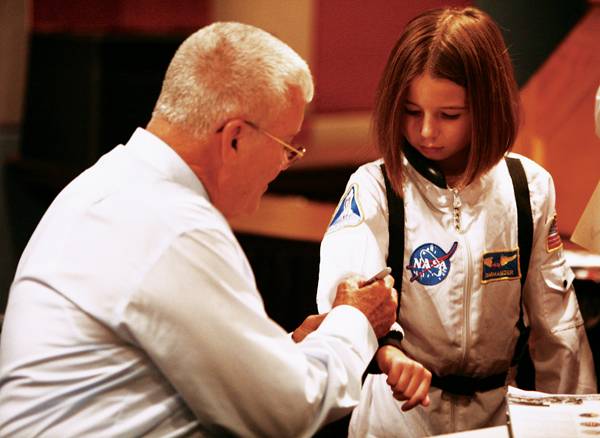Apollo 13 pilot gives inspiration, shares experience

Former NASA astronaut, Fred Haise, signs an autograph to a girl dressed as an astronaut after his lecture, Failure Is Not An Option, on Saturday at Stephens Auditorium. Photo : Jay Bai/Iowa State Daily
September 20, 2009
Michael Gilligan, 12-and-a-half-years-old, stepped up to the microphone and asked boldly, “I was wondering — what should I study if I want to become an astronaut?”
The audience chuckled. The answer, in short, was rocket science.
Gilligan was standing in Stephens Auditorium at Saturday’s free presentation titled “Failure is not an Option,” hosted by Engineers’ Week, a week-long series of festivals and activities aimed at celebrating engineers and promoting networking, professional development and recruitment. Gilligan’s question was addressed to Fred Haise, a former lunar module pilot for the infamous Apollo 13 space mission in 1970.
“Apollo 13 raised the bar,” Haise said.
Fifty-five hours into the moon-bound mission, an oxygen tank in the service module behind the command capsule exploded, forcing the crew members to think on their feet. They powered down the capsule and powered up the lunar module, creating a functional “lifeboat.” After about four days, the astronauts were able to power up the capsule systems and make a safe return to Earth. The mission was widely referred to as a “successful failure.”
“The fact that we got back was not an accident,” Haise said. “We had a process in place.”
He said the ill-fated Apollo mission was different than the popularly portrayed 1995 film “Apollo 13,” starring Tom Hanks. The “actornauts” used much less technical jargon, and there were more people involved in the actual mission than what was implied by the film.
“Today, I feel lucky and privileged to have been a part of the Apollo program,” Haise said. “It took a lot of people to make these things happen.”
Haise was involved in yet another aircraft mishap during a 1973 filming of the Pearl Harbor epic, “Tora! Tora! Tora!” resulting in 65 percent of his body being severely burned. Haise said that incident was more challenging than the Apollo mission to him, because he thought he would never fly again. However, he said that it’s a story he likes to tell.
“You’re going to have some things in your life you have to deal with,” Haise said. “But we have been given the capacity.”
Thomas Rudolphi, professor and interim chair of the department of aerospace engineering, said teamwork is crucial to all engineers. He lived through the Apollo missions and said that although advances in technology were somewhat taken for granted in those days, just as they are today, prospective engineers can still appreciate the significance of the event.
“Some really good on-the-spot thinking and engineering work happened there,” Rudolphi said. “That’s a prime example of teamwork born out of necessity.”
Haise showed actual NASA footage of the Apollo 13 crew working together at the event.
In the slight delay it took to project his video presentation, Haise joked, “Is this Iowa State, we have a problem.”
Jessica Tobelmann, a committee chairperson for Engineers’ Week and senior in chemical engineering, said problem-solving is central to all branches of engineering.
“The problem-solving that they did back then still applies now,” Tobelmann said.
Adam Weaver, co-chairperson and senior in civil engineering, said they try to bring in compelling speakers to students.
“There’s no better example than Fred Haise and Apollo 13,” he said.
















